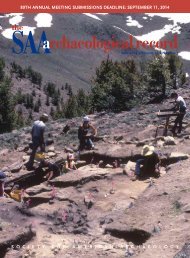SAA
SAA_Record_Nov2015
SAA_Record_Nov2015
Create successful ePaper yourself
Turn your PDF publications into a flip-book with our unique Google optimized e-Paper software.
VOLUNTEER PROFILE<br />
volunteer profile<br />
Sarah Herr<br />
Volunteering has been a big and rewarding part of my life<br />
as an archaeologist. My first volunteer experience was<br />
with the National Park Service Volunteer-in-the-Parks<br />
program after my freshman year of college. Robert (Bob) Powers,<br />
the director of the Bandelier Archaeological Survey,* offered<br />
me the opportunity based on my high school field school at<br />
Crow Canyon experience and references from two families I’d<br />
babysat for (happily, one of those was Tim Kohler’s family). I<br />
was one of three volunteers and we were each assigned to a survey<br />
crew. From May through August we helicoptered or packed<br />
into the backcountry and set up a comfortable camp. For ten<br />
hours a day, for seven eight-day sessions we walked the spectacular,<br />
rugged canyon and mesa landscape of the park. At the<br />
summer’s end, we spent a week recording the big tourist-drawing<br />
front country sites and began our transition back to life with<br />
the rest of humanity (who, at that time, all seemed to wear florescent<br />
pink, adding to the shock of reentry). We recorded sprawling<br />
Archaic flaked stone scatters, the fourteenth century communities<br />
of small village farmers and their dry-farming fields, and<br />
early twentieth century shepherds’ camps with wood stoves<br />
stuffed into tuff caves. I learned, eventually, the ceramics of the<br />
Northern Rio Grande, basic flaked stone analysis, and mapping,<br />
and my proudest accomplishment was reading low level aerial<br />
photographs as we mapped site boundaries tree by tree, or anthill<br />
by anthill—the photos were that clear—in the days before GPS.<br />
That was a life changing summer, and although I volunteered<br />
again the next year, Bob offered me a job instead. I returned each<br />
summer of college until the project ended.<br />
In 1992, shortly after I entered graduate school at the University<br />
of Arizona, I was offered the chance to become the student representative<br />
to the Arizona Archaeological and Historical Society<br />
(AAHS) Board of Directors. My predecessor said “all they ever<br />
do is talk about how to sell baseball hats.” But they did not talk<br />
about hats (they must have resolved that under her term, thankfully).<br />
I have worked with them ever since. Now, I primarily<br />
serve as co-chair of the committee that oversees management of<br />
the journal Kiva. This length of service is not uncommon<br />
among AAHS’s professionals and avocational volunteers.<br />
As I serve on more committees and run for positions on other<br />
boards, including those working at the national level, I have<br />
come to realize my local experience was good preparation.<br />
Archaeological boards share similar concerns even as scale<br />
varies: membership numbers, education and outreach, scholarships,<br />
and publications. My recently ended term representing<br />
cultural resource management professionals on the <strong>SAA</strong> Board<br />
was an extraordinary opportunity to contribute to the national<br />
conversation about how we do archaeology.<br />
Each one of these positions opened new doors for me. If I didn’t<br />
volunteer, I’d still have a wonderful job, but the places I’d have<br />
worked would be fewer; my understanding of the history of the<br />
southwest United States would be informed more by books<br />
than by experience; and my understanding of the ways that people<br />
practice archaeology around the state, country, and world<br />
would be far narrower. Over the next three years, I will be paid<br />
for some of my time and I will volunteer more with Christina<br />
Rieth and Sjoerd van der Linde, co-editing Advances in Archaeological<br />
Practice. I’m looking forward to trying to identify and<br />
publish the best practices of our colleagues, and expanding my<br />
own understanding of our changing profession as we work<br />
together.<br />
*One of the project volunteers was a photographer, then starting<br />
his career as a writer. He documented our summers with fine art<br />
images in a book, now out of print, intended to teach people about<br />
archaeology survey: http://awestthatworks.com/delightmakers.html.<br />
6 The <strong>SAA</strong> Archaeological Record • November 2015




